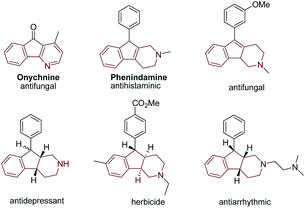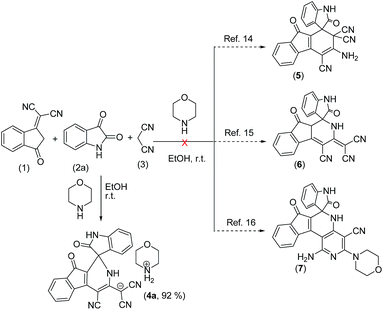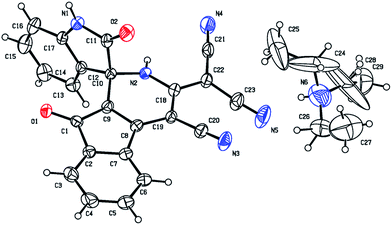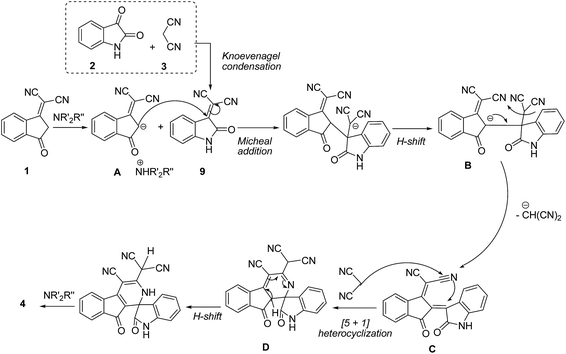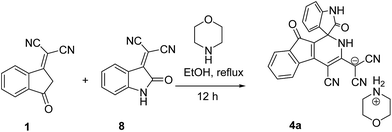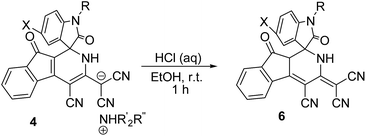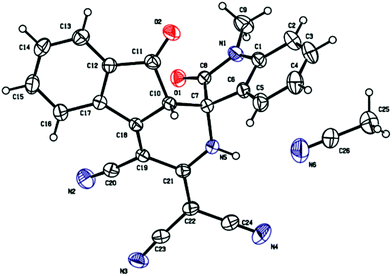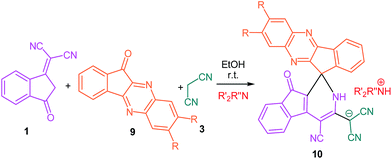A highly efficient one-pot synthesis of indenopyridine-fused spirocyclic systems†
Ghazaleh Imani Shakibaei and
Ayoob Bazgir*
Department of Chemistry, Shahid Beheshti University, General Campus, Tehran 1983963113, Iran. E-mail: a_bazgir@sbu.ac.ir; Tel: +982129903104
First published on 16th February 2016
Abstract
Structurally diverse spirooxindoles incorporating a medicinally privileged indenopyridine moiety have been synthesized regioselectively via multi-component reaction of 1,1-dicyanomethylene-3-indanone, isatins, and malononitrile in the presence of amines in ethanol as an environmentally friendly medium under mild conditions. This domino process includes a [5 + 1] hetrocyclization that occurs under metal-free conditions. The product is a spirooxindole-fused indenopyridine salt that was successfully neutralized by dilute hydrochloric acid. Replacement of isatins with indenoquinoxalines led to the production of dihydrospiro[indeno[1,2-b]quinoxaline-indenopyridine salts in good yields.
Introduction
The search for the efficient transformation of simple starting materials to highly functionalized complex products that combine economic, environmental and green aspects has been an active objective in organic synthesis.1 In this regard, the development and use of multi-component reactions (MCRs) based on group-assisted purification (GAP) chemistry (MCR-GAP) have emerged as a highly valuable synthetic tool to fulfil this goal. The atom economy, convergent character, the possible structural variations, and the accessible complexity of the molecules, are among the described advantages of MCRs. MCRs are economically and environmentally very beneficial because multistep syntheses produce considerable amounts of waste mainly due to complex isolation procedures often involving expensive, toxic, and hazardous solvents after each step.2 Similarly, in GAP chemistry synthesis of organic compounds carry out without using traditional purification methods, such as column chromatography and recrystallization and reduce the waste generated from silica and solvents, particularly toxic solvents; also, to reduce production/synthesis expenses, manpower, and energy.3 In this context, spirooxindoles show interesting features that make them attractive for use in MCR-GAP.The spirocyclic oxindoles have been presented significant biological activities such as progesterone receptor modulators,4 anti-HIV,5 anticancer,6 antitubercular,7 antimalarial,8 MDM2 inhibitor,9 antimicrobial and inhibitors of human NK-1 receptor.10 The spirocyclic oxindole core is a structural centrepiece in a plethora of natural alkaloids, as well as medicinally relevant compounds. The nucleophilic addition and annulations reaction with isatin electrophiles is one of the major strategies that has been widely utilized for the synthesis of spirooxindoles.11
The indenopyridine framework is a privileged heterocyclic scaffold since it appears in 4-azafluorenone group of alkaloids, well known by its simplest member onychnine I (Fig. 1). Other members of this group such as phenindamine II and compounds III–VI have also been displayed fascinating array of biological applications such as insecticidal, phosphodiesterase inhibiting, antifungal, antispermatogenic, antifertility, antagonistic, antidepressant and antiarrhythmic activity.12 It is noteworthy to mention that slight modifications in the nitrogen or aromatic ring substituent and in the degree of unsaturation of the ring system can lead to dramatic changes in its characteristics. This trend is fully evident in 1H-indeno[1,2-c]pyridines II–VI (Fig. 1). Therefore, the synthesis of new heterocycles containing both spirocyclic oxindole and indenopyridine moieties may result in the discovery of new drug candidates.
As part of our program aimed at developing new multi-component reactions for the synthesis of spirooxindole fused indenopyridine,13 herein, we describe, an efficient synthetic approach to structurally diverse spirocycles incorporating indenopyridine moiety by MCR-GAP reactions.
Results and discussion
The reaction of alkylidene-malononitriles, which in the most cases formed in situ in the course of reaction, with several Michael acceptors has been reported and the changes in the nature of the reactants led to the various heterocycles with different structures.14–16 The consideration of previous reports encouraged us to investigate for the first time the reaction of 1,1-dicyanomethylene-3-indanone 1, isatin 2a and malononitrile 3 in the presence of morpholine in EtOH at room temperature (Scheme 1). It was interesting that based on the proposed mechanisms in recent reports, the predicted products 5–7 were not detected at all, while dicyano(4-cyano-2′,9-dioxo-2,9-dihydrospiro[indeno[2,1-c]pyridine-1,3′-indolin]-3-yl) methanide salt 4a was regioselectively obtained in 92% yield after 12 h.Then, this reaction was investigated in various solvents such as H2O, MeOH, THF, CH2Cl2, CHCl3 and MeCN at room temperature for 12 h (Table 1). It was found that the reaction using EtOH resulted in higher yield (entry 6). As can be seen from Table 1, a higher reaction temperature led to a lower yields (entries 7 and 8). It was noted that in the presence of catalytic amount of morpholine, the reaction did not proceed and all the starting materials remained intact.
| Entry | Solvent | T (°C) | Yield (%) |
|---|---|---|---|
| a Dicyanomethylene-3-indanone 1 (1 mmol), isatin 2a (1 mmol), malononitrile 3 (1 mmol), morpholine (1 mmol). Reaction time = 12 h. | |||
| 1 | CH3CN | r.t. | 58 |
| 2 | THF | r.t. | 45 |
| 3 | CH2Cl2 | r.t. | 40 |
| 4 | CHCl3 | r.t. | 43 |
| 5 | H2O | r.t. | — |
| 6 | EtOH | r.t. | 92 |
| 7 | EtOH | 50 °C | 83 |
| 8 | EtOH | Reflux | 80 |
With optimal conditions in hand, we extended the four-component reaction to various isatins and amines to afford desired spirooxindole fused indenopyridine salts 4 in good yields (Table 2). Our literature survey at this stage revealed that this new procedure provides the first example for the synthesis of organic salts incorporating spirooxindole and indenopyridine moieties. According GAP chemistry,3 pure products were obtained simply by evaporation of solvent and washing off the solid with cold diethyl ether. The structures of 4 have been confirmed by IR, 1H NMR, 13C NMR and mass spectroscopy. The structural elucidation was unequivocally determined by X-ray diffraction of single crystal of 4f (Fig. 2).
A plausible reaction scenario for this one-pot process is probably occurs via domino mechanism through Knoevenagle/Micheal/elimination/[5 + 1] cyclisation sequence as outlined in Scheme 2. Initially, anion intermediate A was formed by the deprotonation of 1 in the presence of amine. Then, Michael-type addition reaction of A to 8 (formed in situ by the reaction of 2 and 3), followed by H-shift produce intermediate B. The intermediate C produced by the loss of dicyanomethanide from B. Next, the [5 + 1] heterocyclization of this intermediate with malononitrile 3 led to D. Finally, H-shift and deprotonation by amine afforded product 4. To help clarify the proposed mechanism, first, the isatylidenemalononitrile 8 was synthesized via the condensation of isatin 2a and malononitrile 3 and then the reaction of 8 with 1,1-dicyanomethylene-3-indanone 1 in the presence of morpholine afforded the corresponding product 4a in 95% yield (Scheme 3). The attractive aspect of the present domino reaction is shown by the fact that the construction of 2-azafluorenone-fused spirooxindole skeleton were readily achieved via a metal-free intermolecular domino [5 + 1] heterocyclization in a one-pot operation.
Encouraged by this success, we attempted the neutralization of spirooxindole fused indenopyridine salts 4. We have found that treatment of the salts 4 with diluted hydrochloric acid, in ethanol led to 2-(4-cyano-2′,9-dioxo-9,9a-dihydrospiro[indeno [2,1-c]pyridine-1,3′-indolin]-3(2H)-ylidene)malononitriles 6 in good isolated yields (Table 3). The molecular structure of 6d clearly established by X-ray diffraction analysis (Fig. 3), which confirmed the neutralization of the salt 4.
Next, to perform this reaction in a one-pot two step manner, the reaction of 1,1-dicyanomethylene-3-indanone 1, isatin 2, malononitrile 3 and triethylamine carried out in EtOH at room temperature for 12 h. Then, after completion of the reaction which was monitored by TLC, without isolation of product 4, dilute hydrochloric acid solution was added and the final products 6 were obtained in good isolated yield (Table 4).
Indeno fused quinoxaline, has been found to be an integral part of therapeutically interesting molecules, displaying fascinating spectrum of biological activities such as antimetabolic, antimicrobial, antitubercular and anti-inflammatory properties.17 Considering the very important biologically activities of the molecules containing indenoquinoxaline scaffold, we hypothesize that the integration of indenoquinoxaline moiety with a indenopyridine may result in the discovery of novel drug candidates with unknown biologically activities. Accordingly, we investigated the reaction of 1,1-dicyanomethylene-3-indanone 1, malononitrile 3 and indeno[1,2-b]quinoxalin-11-ones 9 in the presence of various amines under the same reaction conditions and obtained desired dicyano(4′-cyano-9′-oxo-2′,9′-dihydrospiro[indeno[1,2-b]quinoxaline-11,1′-indeno[2,1-c]pyridine]-3′-yl)methanide salts 10 in good isolated yields (Table 5).
Conclusions
In summary, we have disclosed novel green methods for the synthesis of spirocyclic system fused indenopyridine framework which are ubiquitous structural units in a number of biologically active compounds. Features of this strategy include novelty, simplicity, good yields, mild conditions and easy work-up procedures employed. All these properties endowed our system with a salient feature on meeting the requirement of current innovation toward green organic synthesis.Acknowledgements
We gratefully acknowledge financial support from the Research Council of Shahid Beheshti University and the Iranian National Science Foundation (Proposal No: 92033943).Notes and references
- (a) New Avenues to Efficient Chemical Synthesis. Emerging Technologies, P. H. Seeberger and T. Blume, ed. Springer: Heidelberg, 2007, Ernst Schering Foundation Symposium Proceedings 2006–3 Search PubMed; (b) K. C. Nicolaou, E. W. Yue and T. Oshima, in The New Chemistry, ed. N. Hall, Cambridge University Pres s, Cambridge, 2001, pp. 168–198 Search PubMed; (c) L. F. Tietze and F. Hautner, in Stimulating Concepts in Organic Chemistry, ed. F. Vgtle, J. F. Stoddart and M. Shibashaki, Wiley, Weinheim, 2000, pp. 38–64 Search PubMed.
- For recent reviews on multicomponent reactions see: (a) J. D. Sunderhaus and S. F. Martin, Chem.–Eur. J., 2009, 15, 1300 CrossRef CAS PubMed; (b) B. Ganem, Acc. Chem. Res., 2009, 42, 463 CrossRef CAS PubMed; (c) L. F. Tietze, T. Kinzel and C. C. Brazel, Acc. Chem. Res., 2009, 42, 367 CrossRef CAS PubMed; (d) V. Estevez, M. Villacampa and J. C. Menendez, Chem. Soc. Rev., 2010, 39, 4402 RSC; (e) N. R. Candeias, F. Montalbano, P. M. S. D. Cal and P. M. P. Gois, Chem. Rev., 2010, 110, 6169 CrossRef CAS PubMed; (f) B. B. Toure and D. G. Hall, Chem. Rev., 2009, 109, 4439 CrossRef CAS PubMed; (g) B. Jiang, T. Rajale, W. Walter, S.-J. Tu and G. Li, Chem.–Asian J., 2010, 5, 2318 CrossRef CAS PubMed; (h) N. Isambert, M. M. S. Duque, J.-C. Plaquevent, Y. Genisson, J. Rodriguez and T. Constantieux, Chem. Soc. Rev., 2011, 40, 1347 RSC; (i) P. J. Dunn, Chem. Soc. Rev., 2012, 41, 1452 RSC; (j) C. Graaff, E. Ruijter and R. V. A. Orru, Chem. Soc. Rev., 2012, 41, 3969 RSC; (k) A. Domling, W. Wang and K. Wang, Chem. Rev., 2012, 112, 3083 CrossRef CAS PubMed.
- (a) P. Kaur, S. Pindi, W. Wever, T. Rajale and G. Li, Chem. Commun., 2010, 46, 4330 RSC; (b) P. Kaur, S. Pindi, W. Wever, T. Rajale and G. Li, J. Org. Chem., 2010, 75, 5144 CrossRef CAS PubMed; (c) P. Kaur, W. Wever, S. Pindi, R. Milles, P. Gu, M. Shi and G. Li, Green Chem., 2011, 13, 1288 RSC; (d) G. An, C. Seifert and G. Li, Org. Biomol. Chem., 2015, 13, 1600 RSC.
- A. Fensome, W. R. Adams, A. L. Adams, T. J. Berrodin, J. Cohen, C. Huselton, A. Illenberger, J. C. Kern, V. A. Hudak, M. A. Marella, E. G. Melenski, C. C. McComas, C. A. Mugford, O. D. Slayeden, M. Yudt, Z. Zhang, P. Zhang, Y. Zhu, R. C. Winneker and J. E. Wrobel, J. Med. Chem., 2008, 51, 1861 CrossRef CAS PubMed.
- G. Kumari, Nutan, M. Modi, S. K. Gupta and R. K. Singh, Eur. J. Med. Chem., 2011, 46, 1181 CrossRef CAS PubMed.
- (a) M. M.-C. Lo, C. S. Neumann, S. Nagayama, E. O. Perlstein and S. L. Schreiber, J. Am. Chem. Soc., 2004, 126, 16077 CrossRef CAS PubMed; (b) K. Ding, Y. Lu, Z. Nikolovska-Coleska, S. Qui, Y. Ding, W. Gao, J. Stuckey, K. Krajewski, P. P. Roller, Y. Tomita, D. A. Parrish, J. R. Deschamps and S. Wang, J. Am. Chem. Soc., 2005, 127, 10130 CrossRef CAS PubMed.
- V. V. Vintonyak, K. Warburg, H. Kruse, S. Grimme, K. Hubel, D. Rauth and H. Waldmann, Angew. Chem., Int. Ed., 2010, 49, 5902 CrossRef CAS PubMed.
- (a) B. K. S. Yeung, B. Zou, M. Rottmann, S. B. Lakshminarayana, S. H. Ang, S. Y. Leong, J. Tan, J. Wong, S. Keller-Maerki, C. Fischli, A. Goh, E. K. Schmitt, P. Krastel, E. Francotte, K. Kuhen, D. Plouffe, K. Henson, T. Wagner, E. A. Winzeler, F. Petersen, R. Brun, V. Dartois, T. T. Diagana and T. H. Keller, J. Med. Chem., 2010, 53, 5155 CrossRef CAS PubMed; (b) M. Rottmann, C. McNamara, B. K. S. Yeung, M. C. S. Lee, B. Zhou, B. Russell, P. Seitz, D. M. Plouffe, N. V. Dharia, J. Tan, S. B. Cohen, K. R. Spencer, G. E. Gonzalez-Paez, S. B. Lakshminarayana, A. Goh, R. Suwanarusk, T. Jegla, E. K. Schmitt, H.-P. Beck, R. Brun, F. Nosten, L. Renia, V. Dartois, T. H. Keller, D. A. Fidock, E. A. Winzeler and T. T. Diagana, Science, 2010, 329, 1175 CrossRef CAS PubMed.
- K. Ding, Y. Lu, Z. Nikolovska-Coleska, G. Wang, S. Qiu, S. Shangary, W. Gao, D. Qin, J. Stukey, K. Krajewski, P. P. Roller and S. Wang, J. Med. Chem., 2006, 49, 3432 CrossRef CAS PubMed.
- (a) T. Okita and M. Isobe, Tetrahedron, 1994, 50, 11143 CrossRef CAS; (b) P. Rosemmond, M. Hossemi-Merescht and C. Bub, Liebigs Ann. Chem., 1994, 151 CrossRef; (c) M. J. Kornet and A. P. Thio, J. Med. Chem., 1976, 19, 892 CrossRef CAS PubMed.
- G. S. Singh and Z. Y. Desta, Chem. Rev., 2012, 112, 6104 CrossRef CAS PubMed.
- (a) S. D. Crawford, E. G. Rowley, J. R. Eldridge, F. Schuler, D. M. Roush, J. W. Lyga, B. Frank, S. Sehgel, WO 2006089038 A2, 2006Chem. Abstr., 2006, 145, 243208; (b) C. E. Cook, C. D. Sloan, B. F. Thomas and H. A. Navarro, US 2004147539 A1, 2004Chem. Abstr., 2004, 141, 157039; (c) S. A. Hild, M. L. Meistrich, R. P. Blye and J. R. Reel, Biol. Reprod., 2001, 65, 165 CrossRef CAS PubMed; (d) C. Upton, R. H. Osborne and M. Jaffar, Bioorg. Med. Chem. Lett., 2000, 10, 1277 CrossRef CAS PubMed; (e) C. Safak, R. Simsek, Y. Altas, S. Boydag and K. Erol, Bull. Chim. Farm., 1997, 136, 665 CAS; (f) C. E. Cook, Y. W. Lee, M. C. Wani, P. A. Fail and J. M. Jump, U.S. Patent 5,319,084, 1993Chem. Abstr., 1995, 122, 265250a; (g) M. D. Meyer, J. F. De Bernardis and A. A. Hancock, J. Med. Chem., 1994, 37, 105 CrossRef CAS PubMed; (h) R. Kunstmann and G. Fischer, J. Med. Chem., 1984, 27, 1312 CrossRef CAS PubMed.
- (a) G. Imani Shakibaei, A. Feiz, H. R. Khavasi, A. Abolhasani Soorki and A. Bazgir, ACS Comb. Sci., 2011, 13, 96 CrossRef PubMed; (b) A. Feiz, G. Imani Shakibaei, Z. Yasaei, H. R. Khavasi and A. Bazgir, Helv. Chim. Acta, 2011, 94, 1628 CrossRef CAS; (c) G. Imani Shakibaei, A. Feiz and A. Bazgir, C. R. Chim., 2011, 14, 556 CrossRef; (d) R. Ghahremanzadeh, S. Ahadi, G. Imani Shakibaei and A. Bazgir, Tetrahedron Lett., 2010, 51, 499 CrossRef CAS.
- (a) M. A. Sofanf, F. M. El-taweel and A. G. A. Elagamy, J. Prakt. Chem., 1990, 332, 640 CrossRef; (b) X. H. Chen, Z. J. Zhao, Y. Liu, P. Lu and Y. G. Wang, Chem. Lett., 2008, 37, 570 CrossRef CAS; (c) X.-S. Wang, M.-M. Zhang, Q. Li, C.-S. Yao and S.-J. Tu, Tetrahedron, 2007, 63, 5265 CrossRef CAS; (d) N. V. Lakshmi, G. A. S. Josephine and P. T. Perumal, Tetrahedron Lett., 2012, 53, 1282 CrossRef CAS; (e) S.-L. Cui, X.-F. Lin and Y.-G. Wang, J. Org. Chem., 2005, 70, 2866 CrossRef CAS PubMed; (f) L. Rong, H. Han, H. Jiang and S. Tu, Synth. Commun., 2009, 39, 3493 CrossRef CAS; (g) M.-M. Zhang, J.-R. Wu, J. Zhou and X.-S. Wang, Synth. Commun., 2012, 42, 599 CrossRef CAS; (h) M. N. Elinson, A. I. Ilovaisky, V. M. Merkulova, F. Barba and B. Belen, Tetrahedron, 2013, 69, 7125 CrossRef CAS; (i) T. H. Babu, A. A. Joseph, D. Muralidharan and P. T. Perumal, Tetrahedron Lett., 2010, 51, 994 CrossRef.
- (a) F. M. Abdelrazek, N. H. Metwally, N. A. Kassab, N. A. Sobhy, P. Metz and A. Jaeger, J. Heterocycl. Chem., 2010, 47, 384 CAS; (b) Y. T. Abramenko, A. V. Ivashchenko, K. A. Nogaeva and Y. A. Sharanin, Chem. Heterocycl. Compd., 1986, 22, 508 CrossRef; (c) S. Dunkel, U. Heb and G. Reck, J. Prakt. Chem., 1997, 339, 414 CrossRef CAS; (d) H. Karlsen, P. H. Songe, L. K. Sunsby, L. C. Hagen, P. Kolsaker and C. Rømming, J. Chem. Soc., Perkin Trans. 1, 2001, 497 RSC.
- (a) C. Mukhopadhyay, P. Das and R. J. Butcher, Org. Lett., 2011, 13, 4664 CrossRef CAS PubMed; (b) M.-S. Tu, Y. Li, X. Wang, B. Jiang, S.-L. Wang and S.-J. Tu, RSC Adv., 2013, 3, 3877 RSC; (c) P. Das, T. Chaudhuri and C. Mukhopadhyay, ACS Comb. Sci., 2014, 16, 606 CrossRef CAS PubMed.
- (a) K. Iwaki, S. Koya-Miyata, K. Kohno, S. Ushio and S. Fukuda, J. Nat. Med., 2006, 60, 121 CrossRef; (b) I. A. Schepetkin, L. N. Kirpotina, A. I. Khlebnikov, T. S. Hanks, I. Kochetkova, D. W. Pascual, M. A. Jutila and M. T. Quinn, Mol. Pharmacol., 2012, 81, 832 CrossRef CAS PubMed.
Footnote |
| † Electronic supplementary information (ESI) available. CCDC 1437636 and 1437637. For ESI and crystallographic data in CIF or other electronic format see DOI: 10.1039/c6ra00869k |
| This journal is © The Royal Society of Chemistry 2016 |

